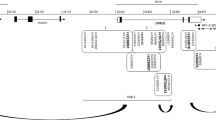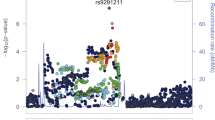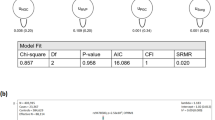Abstract
The mu-opioid receptor (MOR, OPRM1) has important roles in diverse functions including reward, addiction, and response to pain treatment. SNP rs1799971 (118A > G, N40D) which occur at a high frequency (40–60%) in Asia and moderate frequency (15%) in samples of European ancestry, is the only common coding variant in the canonical transcript, in non-African populations. Despite extensive studies, the molecular consequences of this variation remained unresolved. The aim of this study was to determine the genetic background of the OPRM1 region of 118G in four representative populations and to assess its potential modulatory effect. Seven common haplotypes with distinct population distribution were identified based on seven SNPs. Three haplotypes carry the 118G and additional highly linked regulatory SNPs (e.g., rs9383689) that could modulate the effect of 118G. Extended analysis in the 1000 Genomes database (n = 2504) revealed a common East Asian-specific haplotype with a different genetic background in which there are no variant alleles for an upstream LD block tagged by the eQTL rs9397171. The major European haplotype specifically includes the eQTL intronic SNP rs62436463 that must have arisen after the split between European and Asian populations. Differentiating between the effect of 118G and these SNPs requires specific experimental approaches. The analysis also revealed a significant increase in two 118A haplotypes with eQTL SNPs associated with drug addiction (rs510769) and obesity (rs9478496) in populations with native Mexican ancestry. Future studies are required to assess the clinical implication of these findings.
This is a preview of subscription content, access via your institution
Access options
Subscribe to this journal
Receive 12 print issues and online access
$259.00 per year
only $21.58 per issue
Buy this article
- Purchase on Springer Link
- Instant access to full article PDF
Prices may be subject to local taxes which are calculated during checkout



Similar content being viewed by others
References
Prohaska A, Racimo F, Schork AJ, Sikora M, Stern AJ, Ilardo M, et al. Human disease variation in the light of population genomics. Cell. 2019;177:115–31.
Crist RC, Reiner BC, Berrettini WH. A review of opioid addiction genetics. Curr Opin Psychol. 2019;27:31–5.
Kreek MJ, Levran O, Reed B, Schlussman SD, Zhou Y, Butelman ER. Opiate addiction and cocaine addiction: underlying molecular neurobiology and genetics. J Clin Invest. 2012;122:3387–93.
Pasternak GW, Pan YX. Mu opioids and their receptors: evolution of a concept. Pharm Rev. 2013;65:1257–317.
Lopez Soto EJ, Catanesi CI. Human population genetic structure detected by pain-related mu opioid receptor gene polymorphisms. Genet Mol Biol. 2015;38:152–5.
Bond C, LaForge KS, Tian M, Melia D, Zhang S, Borg L, et al. Single-nucleotide polymorphism in the human mu opioid receptor gene alters beta-endorphin binding and activity: possible implications for opiate addiction. Proc Natl Acad Sci USA. 1998;95:9608–13.
Burns JA, Kroll DS, Feldman DE, Kure Liu C, Manza P, Wiers CE, et al. Molecular imaging of opioid and dopamine systems: insights into the pharmacogenetics of opioid use disorders. Front Psychiatry. 2019;10:626.
Levran O, Yuferov V, Kreek MJ. The genetics of the opioid system and specific drug addictions. Hum Genet. 2012;131:823–42.
Mague SD, Blendy JA. OPRM1 SNP (A118G): involvement in disease development, treatment response, and animal models. Drug Alcohol Depend. 2010;108:172–82.
Zhang X, Liang Y, Zhang N, Yan Y, Liu S, Fengxi H, et al. The relevance of the OPRM1 118A>G genetic variant for opioid requirement in pain treatment: a meta-analysis. Pain Physician. 2019;22:331–40.
Ray LA, Barr CS, Blendy JA, Oslin D, Goldman D, Anton RF. The role of the Asn40Asp polymorphism of the mu opioid receptor gene (OPRM1) on alcoholism etiology and treatment: a critical review. Alcohol Clin Exp Res. 2012;36:385–94.
Haerian BS, Haerian MS. OPRM1 rs1799971 polymorphism and opioid dependence: evidence from a meta-analysis. Pharmacogenomics. 2013;14:813–24.
Chen D, Liu L, Xiao Y, Peng Y, Yang C, Wang Z. Ethnic-specific meta-analyses of association between the OPRM1 A118G polymorphism and alcohol dependence among Asians and Caucasians. Drug Alcohol Depend. 2012;123:1–6.
Mura E, Govoni S, Racchi M, Carossa V, Ranzani GN, Allegri M, et al. Consequences of the 118A>G polymorphism in the OPRM1 gene: translation from bench to bedside? J Pain Res. 2013;6:331–53.
Pecina M, Zubieta JK. Expectancy modulation of opioid neurotransmission. Int Rev Neurobiol. 2018;138:17–37.
Fournier T, Schacherer J. Genetic backgrounds and hidden trait complexity in natural populations. Curr Opin Genet Dev. 2017;47:48–53.
Hwang IC, Park JY, Myung SK, Ahn HY, Fukuda K, Liao Q. OPRM1 A118G gene variant and postoperative opioid requirement: a systematic review and meta-analysis. Anesthesiology. 2014;121:825–34.
Hernandez-Avila CA, Covault J, Wand G, Zhang H, Gelernter J, Kranzler HR. Population-specific effects of the Asn40Asp polymorphism at the mu-opioid receptor gene (OPRM1) on HPA-axis activation. Pharmacogenet Genomics. 2007;17:1031–8.
Genomes Project Consortium, Auton A, Brooks LD, Durbin RM, Garrison EP, Kang HM, et al. A global reference for human genetic variation. Nature. 2015;526:68–74.
Levran O, Awolesi O, Linzy S, Adelson M, Kreek MJ. Haplotype block structure of the genomic region of the mu opioid receptor gene. J Hum Genet. 2011;56:147–55.
Levran O, Even-Tov E, Zhao L. A hominid-specific shift in cerebellar expression, upstream retrotransposons, and a potential cis-regulatory mechanism: bioinformatics analyses of the mu-opioid receptor gene. Heredity. 2020;124:325–35.
Lonsdale J, Thomas J, Salvatore M, Phillips R, Lo E, Shad S, et al. The Genotype-Tissue Expression (GTEx) project. Nat Genet. 2013;45:580.
Norris ET, Wang L, Conley AB, Rishishwar L, Marino-Ramirez L, Valderrama-Aguirre A, et al. Genetic ancestry, admixture and health determinants in Latin America. BMC Genomics. 2018;19:861.
Levran O, Londono D, O’Hara K, Nielsen DA, Peles E, Rotrosen J, et al. Genetic susceptibility to heroin addiction: a candidate gene association study. Genes Brain Behav. 2008;7:720–9.
Hancock DB, Levy JL, Gaddis NC, Glasheen C, Saccone NL, Page GP, et al. Cis-expression quantitative trait loci mapping reveals replicable associations with heroin addiction in OPRM1. Biol Psychiatry. 2015;78:474–84.
Tolami HF, Sharafshah A, Tolami LF, Keshavarz P. Haplotype-based association and in silico studies of OPRM1 gene variants with susceptibility to opioid dependence among addicted iranians undergoing methadone treatment. J Mol Neurosci. 2020;70:504–13.
Zhang H, Luo X, Kranzler HR, Lappalainen J, Yang BZ, Krupitsky E, et al. Association between two mu-opioid receptor gene (OPRM1) haplotype blocks and drug or alcohol dependence. Hum Mol Genet. 2006;15:807–19.
Lappalainen T, Montgomery SB, Nica AC, Dermitzakis ET. Epistatic selection between coding and regulatory variation in human evolution and disease. Am J Hum Genet. 2011;89:459–63.
Hartwell EE, Feinn R, Morris PE, Gelernter J, Krystal J, Arias AJ et al. Systematic review and meta-analysis of the moderating effect of rs1799971 in OPRM1, the mu-opioid receptor gene, on response to naltrexone treatment of alcohol use disorder. Addiction 2020.
Xu J, Xu M, Hurd YL, Pasternak GW, Pan YX. Isolation and characterization of new exon 11-associated N-terminal splice variants of the human mu opioid receptor gene. J Neurochem. 2009;108:962–72.
Tishkoff SA, Reed FA, Friedlaender FR, Ehret C, Ranciaro A, Froment A, et al. The genetic structure and history of Africans and African Americans. Science. 2009;324:1035–44.
Avila-Arcos MC, McManus KF, Sandoval K, Rodriguez-Rodriguez JE, Villa-Islas V, Martin AR, et al. Population History and Gene Divergence in Native Mexicans Inferred from 76 Human Exomes. Mol Biol Evol. 2020;37:994–1006.
Ducat E, Ray B, Bart G, Umemura Y, Varon J, Ho A, et al. Mu-opioid receptor A118G polymorphism in healthy volunteers affects hypothalamic-pituitary-adrenal axis adrenocorticotropic hormone stress response to metyrapone. Addict Biol. 2013;18:325–31.
Chong RY, Oswald L, Yang X, Uhart M, Lin PI, Wand GS. The mu-opioid receptor polymorphism A118G predicts cortisol responses to naloxone and stress. Neuropsychopharmacology. 2006;31:204–11.
Wand GS, McCaul M, Yang X, Reynolds J, Gotjen D, Lee S, et al. The mu-opioid receptor gene polymorphism (A118G) alters HPA axis activation induced by opioid receptor blockade. Neuropsychopharmacology. 2002;26:106–14.
Halikere A, Popova D, Scarnati MS, Hamod A, Swerdel MR, Moore JC, et al. Addiction associated N40D mu-opioid receptor variant modulates synaptic function in human neurons. Mol Psychiatry. 2020;25:1406–19.
Gallagher MD, Chen-Plotkin AS. The Post-GWAS Era: from association to function. Am J Hum Genet. 2018;102:717–30.
Kichaev G, Bhatia G, Loh PR, Gazal S, Burch K, Freund MK, et al. Leveraging polygenic functional enrichment to improve GWAS power. Am J Hum Genet. 2019;104:65–75.
Tian C, Gregersen PK, Seldin MF. Accounting for ancestry: population substructure and genome-wide association studies. Hum Mol Genet. 2008;17:R143–50.
Bodnar RJ. Endogenous opioid modulation of food intake and body weight: Implications for opioid influences upon motivation and addiction. Peptides. 2019;116:42–62.
Sweeney CG, Rando JM, Panas HN, Miller GM, Platt DM, Vallender EJ. Convergent balancing selection on the mu-opioid receptor in primates. Mol Biol Evol. 2017;34:1629–43.
Crystal HA, Hamon S, Randesi M, Cook J, Anastos K, Lazar J, et al. A C17T polymorphism in the mu opiate receptor is associated with quantitative measures of drug use in African American women. Addict Biol. 2012;17:181–91.
Acknowledgements
This work was supported by The Dr. Miriam and Sheldon G. Adelson Medical Research Foundation.
Author information
Authors and Affiliations
Corresponding author
Ethics declarations
Conflict of interest
The authors declare that they have no conflict of interest.
Additional information
Publisher’s note Springer Nature remains neutral with regard to jurisdictional claims in published maps and institutional affiliations.
Supplementary information
Rights and permissions
About this article
Cite this article
Levran, O., Kreek, M.J. Population-specific genetic background for the OPRM1 variant rs1799971 (118A>G): implications for genomic medicine and functional analysis. Mol Psychiatry 26, 3169–3177 (2021). https://doi.org/10.1038/s41380-020-00902-4
Received:
Revised:
Accepted:
Published:
Issue Date:
DOI: https://doi.org/10.1038/s41380-020-00902-4
This article is cited by
-
The effects of OPRM1 118A>G on methadone response in pain management in advanced cancer at end of life
Scientific Reports (2024)
-
Multi-trait genome-wide association study of opioid addiction: OPRM1 and beyond
Scientific Reports (2022)



